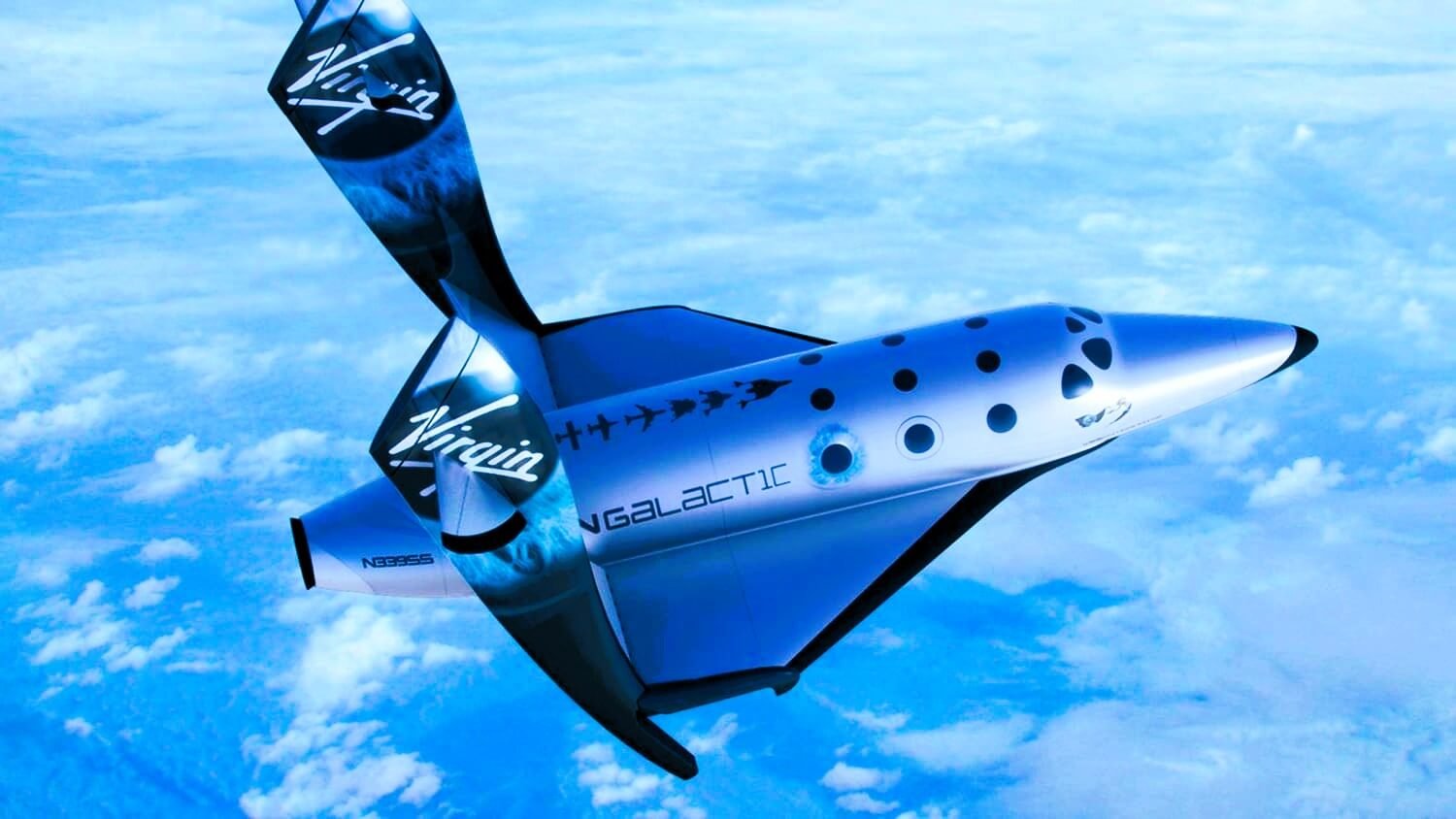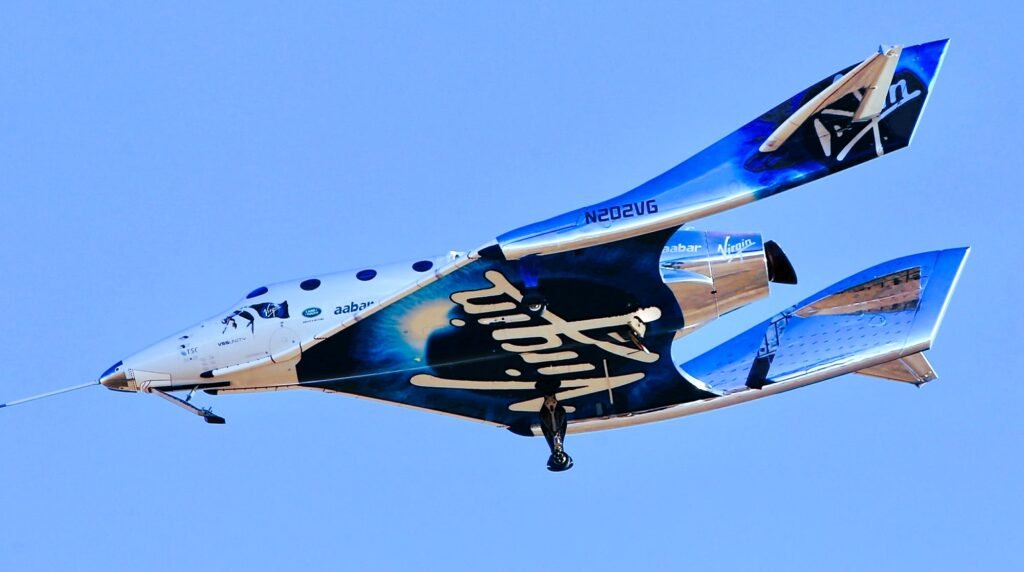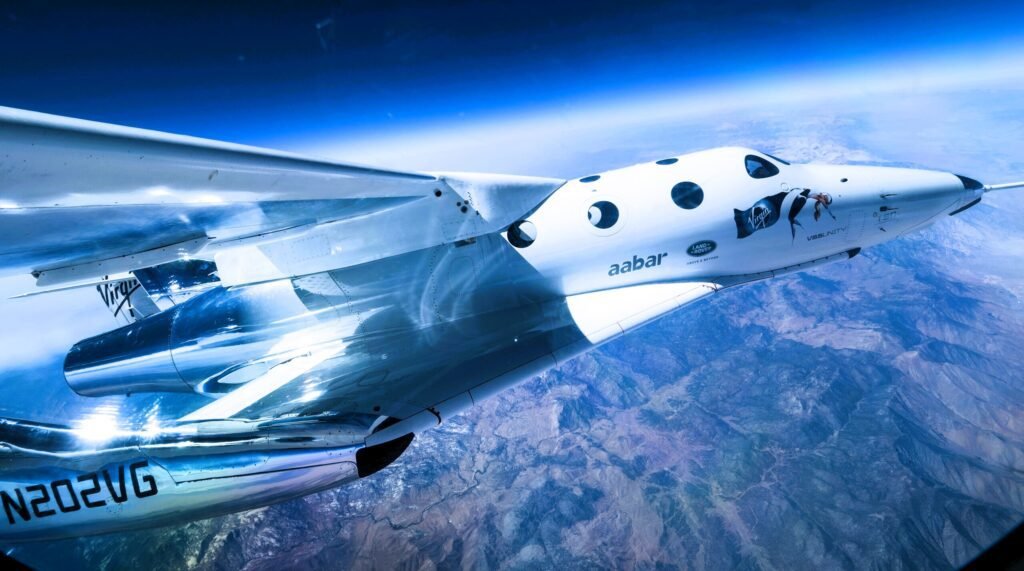
As the sun begins to rise over the rugged San Andreas Mountains, a peculiar sight comes into view on the horizon an enormous, spaceship-like structure nestled in the New Mexican desert. This structure is home to none other than Virgin Galactic, a company that has spent nearly two decades striving to establish itself as a pioneer in space tourism.
Table of Contents
Virgin Galactic, A Roller Coaster Ride of Ambitions

Founded almost two decades ago by Sir Richard Branson, Virgin Galactic embarked on a bold journey to become the first-ever space tourism business. From soaring stock prices of $56 per share to a plummet barely above $3, and from the tragic crash of one of its spaceships nine years ago to its recent triumphant flights, the company has seen it all.
Rising from the Ashes
In early August, a rocket blast resonated through the New Mexico desert as Virgin Galactic’s seventh flight, named Galactic 02, marked a significant milestone. This was the first instance the company carried a private astronaut into space, a key objective it had been pursuing. More than a thousand individuals have invested in the Virgin Galactic experience, eagerly anticipating a few minutes of weightlessness and an awe-inspiring rocket ride to the pinnacle of the Earth’s atmosphere.
Among these brave souls was Jon Goodwin, an 80-year-old British businessman. Having purchased his ticket way back in 2005, Goodwin, who battles Parkinson’s disease, saw this opportunity as a way to defy the odds and inspire others facing similar challenges. Joining him were Keisha Schahaff and Anastatia Mayers, a mother-daughter duo from the Caribbean whose tickets were provided by the nonprofit Space for Humanity, a step toward fulfilling Virgin Galactic’s promise of making space accessible to a wider demographic.
Flight to the Financial Frontier
The financial landscape of Virgin Galactic is equally fascinating. After becoming a publicly traded company in 2019, its most recent financial statement boasts a robust $980 million in cash. Despite this, the company reported a quarterly loss of $134 million, partly due to investments in its futuristic spaceship line and the employment of over 1,100 staff members.
The road ahead poses challenges, as the company’s spending rate remains high. Each spaceflight involves significant costs, particularly due to the need for engine replacements. Consequently, the company must secure funding to sustain its operations for the next few years until it reaches a profitable stage.
Aiming for the Stars
Why then, amidst financial complexities, is Virgin Galactic persistently taking to the skies? The answer lies in the need to demonstrate technical prowess, reassure investors, and offer customers a tantalizing glimpse of what’s to come. The company’s plans for profitability are contingent on surviving the “valley of death” period, a prolonged phase before substantial cash generation.
Towards a New Cadence
The recent flight cadence showcases Virgin Galactic’s determination to evolve. The company’s president, Mike Moses, a former NASA engineer, has been instrumental in redefining its flight operations. Following modifications, which focused on reducing post-flight inspection times, Virgin Galactic has achieved a more frequent flight schedule, aiming for monthly launches.
Moses highlighted the success of these modifications, such as redesigning a part on the carrier aircraft to enhance durability. By addressing aerodynamic challenges, engineers have achieved positive results, proving the viability of their strategies.
The Path Ahead: Unveiling the Cosmos and Overcoming Challenges

As Virgin Galactic takes bold strides in its pursuit of space tourism, questions linger about its sustainability and future direction. With each successful flight, the company inches closer to its aspirations. However, challenges remain, from financial constraints to the need for consistent operational excellence. The journey ahead is filled with uncertainty, but one thing is clear—Virgin Galactic’s determination and innovation will continue to reshape the future of space travel.
Selling an Experience: The Luxurious Journey with Virgin Galactic
In the realm of luxury experiences, Virgin Galactic stands out with its unparalleled offering – spaceflight. While the cost of a ticket may be beyond reach for most, the journey is nothing short of opulent. From the sprawling spaceport in New Mexico to the intricacies of the preparation process, Virgin Galactic offers an adventure that transcends traditional tourism.
A Glimpse into the Unveiling
The journey begins as customers step into the spaceport in New Mexico. The entrance leads through a tunnel that gradually opens up, revealing the production floor below. The sight of the spacecraft coupled with its carrier aircraft is a sight to behold, evoking awe and anticipation. Unfortunately, capturing this moment through pictures is prohibited, preserving the allure for those who embark on this extraordinary voyage.
Immersion in Preparation
Prospective astronauts, regardless of debates surrounding their title, spend a substantial portion of their three-day journey at the “Astra” facility on the third floor of the main building. This facility serves as both a training ground and a relaxation haven. A full-scale replica of the spacecraft provides an opportunity for astronauts to acquaint themselves with the experience they are about to undertake, fostering a sense of familiarity and confidence.
Beyond the Skies: The Flight Experience
Unlike traditional spaceflights, Virgin Galactic passengers take off from a runway similar to an aeroplane. Once in space, the spacecraft glides back to Earth, offering a unique and serene descent. This differentiates Virgin Galactic from its competitor, Blue Origin, where passengers land in parachutes within a capsule. The divergent experiences cater to various preferences, making Virgin Galactic’s offering even more distinctive.
Supply and Demand Dynamics
Virgin Galactic and Blue Origin’s suborbital space tourism services have seen unprecedented demand, outstripping their capacity. While Blue Origin encountered setbacks, including an accident during an uncrewed flight, Virgin Galactic’s consistent approach has garnered attention. The competition in this field boils down to execution – the ability to fly frequently and safely.
Navigating the Challenges
Virgin Galactic’s journey to become a key player in commercial spaceflights presents its own set of challenges. Despite its ambition, the company operates with limited resources. The introduction of new spacecraft designs, including the Delta-class, aims to address issues of profitability, maintenance, and manufacturability. The focus on a more efficient fleet underscores the company’s determination to succeed.
The Delta-class Frontier
The Delta-class spacecraft, with its envisioned capacity of carrying six passengers, promises an enhanced frequency of flights. Virgin Galactic’s aspiration to achieve 400 flights annually hinges on the success of these new vessels. Drawing from the design of Unity, these ships are poised to leverage existing data for expedited testing. However, challenges in design, construction, and timelines loom large.
A Waiting Game

The reality of the Delta-class ships entering commercial service remains a distant goal. Construction and testing timelines point to a potential launch no earlier than late 2026, a delay that is not uncommon in the realm of spaceflight. For the foreseeable future, VSS Unity remains the backbone of Virgin Galactic’s operations.
Paving the Path Ahead
The journey towards establishing Virgin Galactic as a pioneering spaceflight company is a multifaceted endeavour. The company’s success hinges on its ability to execute the vision laid out by its founder, Richard Branson. While the road ahead is riddled with challenges, the progress Virgin Galactic has demonstrated, including its near-monthly cadence with VSS Unity, instil confidence in the endeavour’s viability.
A Vision of Tomorrow
Leaving the planet, if only briefly, through the window of a Virgin Galactic spacecraft instills a profound sense of responsibility for our world. As the era of commercial spaceflight unfurls its wings, it offers an opportunity to raise awareness about Earth’s fragility. Virgin Galactic’s audacious endeavour embodies the spirit of exploration and discovery, reminding us of our duty to protect our planet.
Uncertain Horizons
While optimism surrounds Virgin Galactic’s journey, the company faces formidable challenges. The success of the Delta-class ships is pivotal, and any setbacks or delays could alter the course significantly. The quest to achieve consistent commercial operations is characterized by uncertainties and obstacles that demand perseverance and innovation.
FAQs
1. How did Virgin Galactic begin its journey into space tourism?
Virgin Galactic was founded by Sir Richard Branson almost two decades ago with the ambitious goal of becoming the world’s first space tourism business.
2. What milestone did Galactic 02 achieve?
Galactic 02 marked Virgin Galactic’s first flight carrying a private astronaut into space, signifying a significant step toward achieving its space tourism objectives.
3. What challenges does Virgin Galactic face in terms of finances?
While the company has a substantial cash reserve, its spending rate is high. The need for engine replacements after each flight and other expenditures could exhaust its funds within two years without additional funding.
4. How does Virgin Galactic plan to become profitable?
Virgin Galactic’s profitability plan hinges on surviving the next few years while continuing to demonstrate technical capabilities, reassure investors, and showcase the experience it offers customers.
5. What recent changes have occurred in Virgin Galactic’s flight operations?
Following modifications to its spacecraft, Virgin Galactic has transitioned to a more frequent flight cadence, with the goal of achieving monthly spaceflight launches.
Conclusion
Virgin Galactic’s pursuit of making space tourism a reality for enthusiasts worldwide is a testament to human innovation and aspiration. The luxury of spaceflight and the prospect of leaving Earth’s confines underscore the essence of this experience. As Virgin Galactic navigates through trials and triumphs, the prospect of opening space to a broader audience remains an exhilarating adventure. While financial challenges and operational complexities remain, the company’s determination to make space accessible to more people is evident. With each flight, Virgin Galactic showcases its commitment to innovation and its vision of a future where space travel is within reach for all. As the company continues to redefine possibilities, it leaves us all wondering—will Virgin Galactic truly take us to the stars? Only time will unveil the answer.






Emirates Premium Economy: The Ultimate Travel Experience - Finance News
Chandrayaan-3: India's Moon Lander Vikram Aims for Historic Lunar South Pole Landing - Finance News